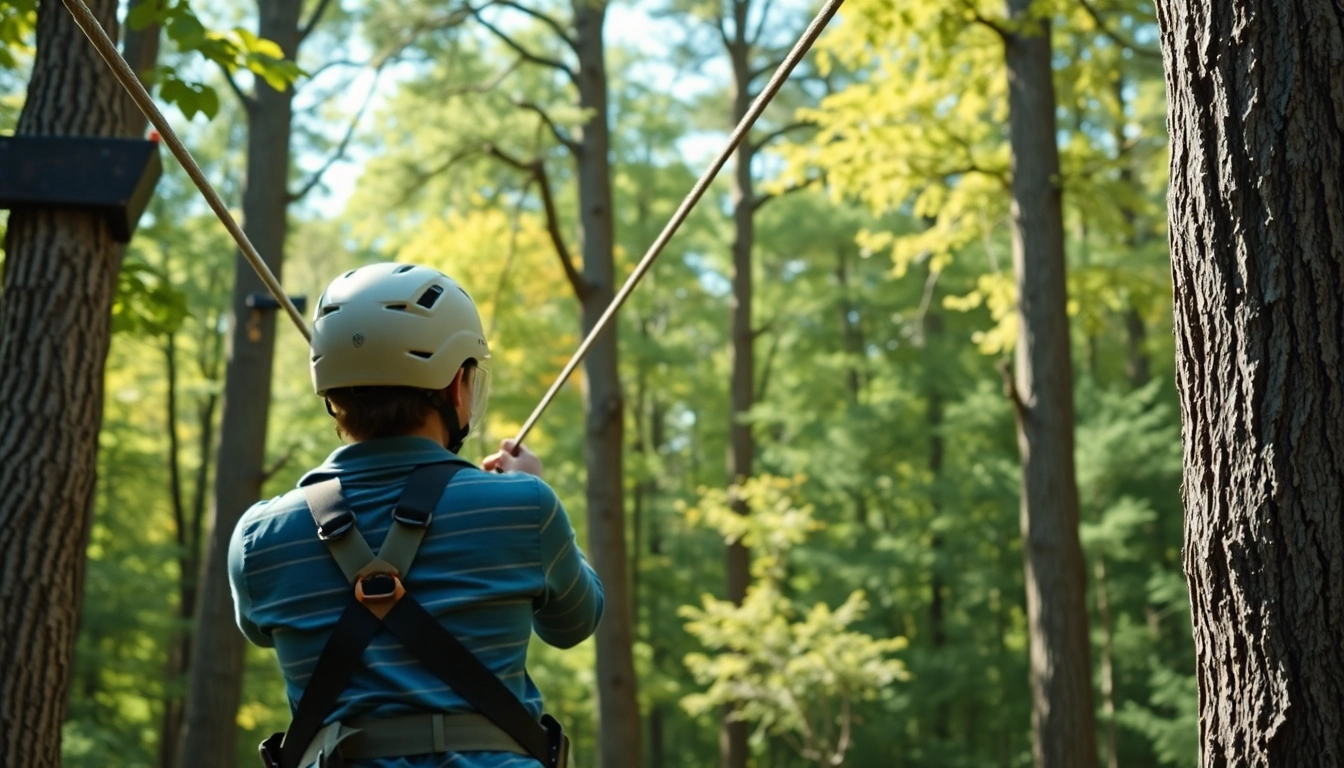Understanding ZIP WIRE KITS
When it comes to elevating your outdoor adventures, ZIP WIRE KITS offer a thrilling experience that combines adrenaline with the beauty of nature. These kits allow individuals to set up their own zip lines, transforming gardens, forests, or any suitable outdoor space into a playground of excitement. But what exactly are ZIP WIRE KITS, and what do you need to know to choose or use them safely?
What Are ZIP WIRE KITS?
ZIP WIRE KITS are essentially packages that provide all the necessary components to create a zip line experience. These kits are designed to be user-friendly, making it possible for enthusiasts of all skill levels to set up their own zip lines without professional assistance. Typically, a ZIP WIRE KIT will include components such as cable, pulleys, supports, and braking systems, allowing you to create a thrilling descent through the air. The simplicity and excitement of these kits have made them increasingly popular for backyard entertainment, as well as commercial use in adventure parks and recreational facilities.
Components of ZIP WIRE KITS
A standard ZIP WIRE KIT consists of several key components:
- Cable: This is the core of the zip wire, usually made of durable steel or another heavy-duty material designed to withstand tension and weight.
- Pulleys: Pulleys are used to allow smooth travel along the cable. High-quality pulleys reduce friction and enhance performance.
- Supports: Supports are necessary to set up the cable at the appropriate height and angle, ensuring a safe and enjoyable ride.
- Harnesses: Safety harnesses are essential for user security, keeping riders safely strapped in as they zip along the line.
- Braking Systems: A reliable braking system prevents injuries by slowing down and halting the rider’s motion safely.
Understanding these components is crucial, as the quality and compatibility of each part can significantly impact the safety and enjoyment of your zip line experience.
Safety Features of ZIP WIRE KITS
The safety features incorporated into ZIP WIRE KITS are paramount. Common safety elements include:
- High Weight Capacity: Most kits are designed to support a wide range of weights, ensuring that users can enjoy the ride safely.
- Durable Materials: The components are typically constructed with rust-resistant materials and engineered for longevity and extreme weather conditions.
- Fail-Safe Mechanisms: Some ZIP WIRE KITS come equipped with fail-safe braking systems that automatically engage in case of a malfunction.
- Comprehensive Installation Guides: Quality kits provide detailed instructions to prevent incorrect setup and usage.
These safety features should always be verified before purchase, as they are crucial in ensuring a fun yet safe zip line experience.
Choosing Quality ZIP WIRE KITS
Selecting the right ZIP WIRE KITS requires due diligence and attention to detail. The safety and enjoyment of your zip line depend on the quality of the kit you choose. Here are some critical factors to consider.
Factors to Consider When Selecting ZIP WIRE KITS
When evaluating ZIP WIRE KITS, consider the following:
- Intended Use: Consider whether the kit is meant for personal use, commercial use, or for children. Each type demands different safety and design specifications.
- Weight Limits: Ensure the weight limit meets the requirements of all potential users. A reputable kit should clearly state this limit.
- Installation Requirements: Some kits require more complicated installation processes than others. Understand your skills and whether you need professional help.
- Material Quality: Assess whether the materials used in the kit are durable and rust-resistant, as this affects longevity.
- Brand Reputation: Buying from established brands can offer peace of mind regarding quality and support.
Top Brands of ZIP WIRE KITS
While we won’t reference specific companies here, several brands have earned a strong reputation for quality ZIP WIRE KITS. Research these brands based on their reviews, customer service, and warranty offers. A brand with a track record of reliability and high satisfaction rates can significantly contribute to your confidence in a purchase.
Customer Reviews and Ratings of ZIP WIRE KITS
User-generated feedback can be invaluable when selecting the right kit. Look for comprehensive reviews and ratings that touch upon various aspects such as installation ease, durability, safety, and overall satisfaction. Engage in online forums or dedicated review sites to learn from the experiences of other users.
Installation of ZIP WIRE KITS
Successful installation is critical in ensuring safety and functionality for your zip line. Here’s an overview of what to expect in the installation process.
Basic Tools Required for ZIP WIRE KITS Installation
Before starting the installation of ZIP WIRE KITS, ensure you have the following tools:
- Drill: Necessary for attaching supports and other components.
- Wrenches: To secure bolts and nuts effectively.
- Measuring Tape: To measure distances and proper heights.
- Level: Ensures your cable is set up at the correct angle.
- Safety Gear: Gloves and goggles are recommended to protect against injuries during installation.
Step-by-Step Guide to Installing ZIP WIRE KITS
The installation of ZIP WIRE KITS typically follows these steps:
- Choose the Location: Select a location that allows enough space for both the zip line and safe landing.
- Set the Supports: Securely install the support structures to hold the cable. Ensure they are spaced appropriately and can bear the load.
- Attach the Cable: Thread the cable through pulleys and secure it tightly to the supports.
- Install the Braking System: Ensure the braking system is properly integrated to halt the ride at the end of the zip line.
- Conduct Safety Checks: After installation, check every component thoroughly to ensure safety.
Following these steps enables a safer and more enjoyable zip line experience.
Common Mistakes to Avoid During ZIP WIRE KITS Installation
Preventative measures can save significant headaches during installation. Common mistakes include:
- Incorrect Measurements: Always double-check measurements before cutting or drilling to avoid costly errors.
- Inadequate Support: Never underestimate the need for robust support structures; weak supports can lead to accidents.
- Ignoring Safety Guidelines: Always adhere to the manufacturer’s guidelines for installation to prevent malfunctions.
- Overlooking Maintenance Needs: Ensure that your installation allows access for routine inspections and maintenance.
Using ZIP WIRE KITS Safely
Once your ZIP WIRE KITS are installed, understanding safe usage is critical to maximizing enjoyment while minimizing risks.
Pre-ride Safety Checks for ZIP WIRE KITS
Before embarking on your zip line adventure, conducting thorough safety checks can make all the difference:
- Inspect the Cable: Look for wear and tear or visible damage that could jeopardize safety.
- Check the Braking System: Ensure brakes are functioning correctly to prevent accidents during dismount.
- Review Harness Fit: Ensure that all harnesses used are secure and fit each user properly.
- Communicate Rules: Discuss safety rules and ride expectations with all participants.
Essential Tips for Riding ZIP WIRE KITS
Maximize your enjoyment while minimizing risks by adhering to safety tips:
- Follow Weight Limits: Ensure each rider is within the weight limit of the kit.
- Take Turns: Avoid crowding on the zip line by allowing one user at a time.
- Keep Hands In: Always keep hands inside the harness and away from the cable.
- Stay Calm: Remind riders to remain calm and follow the setup instructions while riding.
Emergency Procedures for ZIP WIRE KITS Users
In case of emergencies, it’s essential to know what to do:
- Signal Distress: Establish a hand signal for emergencies to alert personnel below.
- Know Your Environment: Familiarize riders with the layout of the area to prepare for emergency scenarios.
- Have Rescue Plans: Plan for various emergencies, including equipment failure or a rider stuck mid-ride.
- First Aid Preparation: Always have a first-aid kit ready and accessible during operations.
Maintaining Your ZIP WIRE KITS
Regular maintenance is a critical aspect of ensuring the longevity and safety of your ZIP WIRE KITS. Here’s how to maintain your setup effectively.
Routine Maintenance Checklist for ZIP WIRE KITS
A regular maintenance check should include:
- Inspect Cables: Look for fraying, rust, or any other signs of wear regularly.
- Check Pulleys: Ensure that pulleys are spinning smoothly; clean them from dirt and debris.
- Examine Braking Systems: Check functionality and ensure they have not worn down since the last inspection.
- Review Supports: Ensure all support structures are stable and secure.
When to Replace Components in ZIP WIRE KITS
It’s crucial to know when to replace different ZIP WIRE KIT components:
- Cables: Replace cables immediately at the first sign of wear.
- Pulleys: If pulleys show signs of scratching or resistance, they should be replaced.
- Brakes: A gradual decline in braking performance indicates it’s time for a replacement.
- Supports: Replace supports if they show signs of rot, corrosion, or instability.
Benefits of Regular Maintenance for ZIP WIRE KITS
Regularly maintaining your ZIP WIRE KITS can lead to numerous benefits:
- Increased Safety: Routine checks help prevent accidents due to equipment failure.
- Longer Lifespan: Proper maintenance extends the life of your equipment.
- Retained Value: Well-maintained kits have better resale value if you intend to upgrade.
- Enhanced Performance: Regular upkeep ensures optimal performance during rides.



